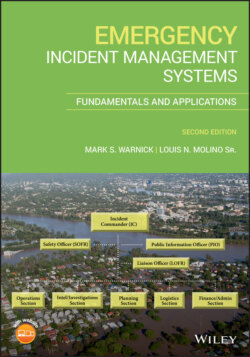Читать книгу Emergency Incident Management Systems - Mark Warnick S., Louis N. Molino Sr - Страница 54
2.4.2.2 At the State Emergency Operations Center
ОглавлениеAs was described earlier, the blast occurred at 9:02 a.m., and agencies on scene immediately began requesting additional resources. Documentation by the State Emergency Operation Center (EOC) revealed that the full activation of the EOC was requested at 9:04 a.m., only two minutes after the explosion. Within 25 minutes, the EOC was fully staffed and a representative was onsite of the explosion to be a liaison between the Incident Commander (IC) and the EOC.
The purpose of an EOC was to establish a centralized site where government (at any level) can provide interagency coordination and execute decision‐making to support an incident response. In the EOC, there may be a multitude of experts in specific areas that can provide expertise and/or resources to the Incident Commander (IC) and the General Staff that are commanding the incident. As an example, when the state EOC was activated, the agencies that staffed it included the Oklahoma Department of Public Safety, the Oklahoma Department of Human Services, the Oklahoma Military Department, the Oklahoma Department of Health and the Oklahoma Department of Education. Not long thereafter, the National Weather Service, the Civil Air Patrol, and the American Red Cross were brought in to staff the EOC for their specialization.
On the ground, roles and responsibilities were quickly assigned by the Incident Commander (IC) with the majority of support being ordered by the EOC. While the search and rescue operations were initially managed by the Oklahoma City Fire Department, the outer security perimeter was initially managed by Oklahoma City Police Department and the Oklahoma County Sheriff's Department. Later, other Oklahoma State law enforcement officers and National Guard were integrated into security.
Eventually, the rescue operation included 11 federalized Urban Search and Rescue (US&R) Teams from local agencies across the nation. Firefighters from more than 75 Oklahoma communities and more than 35 departments from Texas, Kansas, Arkansas, and other states participated. In all, FEMA deployed more than 1000 of its own employees and hundreds from other federal agencies. The American Red Cross provided food and shelter for emergency personnel and support for victims and their families. Private firms ranging from building supply companies to funeral homes to restaurants supported the responders. The scale of the operation required resources from all levels of government and a wide variety of nongovernmental organizations.
The bombing was a federal crime involving a federal facility that resulted in the deaths of federal officers and employees. The legal jurisdiction for the investigation resided with the Federal Bureau of Investigation and other federal law enforcement agencies, who integrated local agencies. While the response had a few issues, they were relatively minor when compared to other incidents of similar size.
